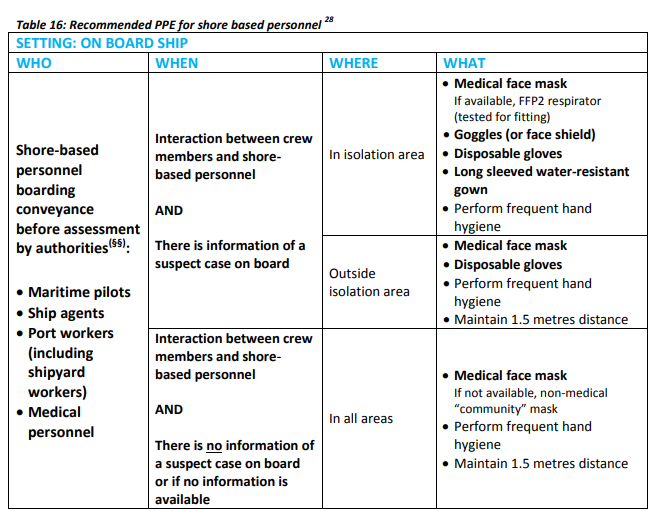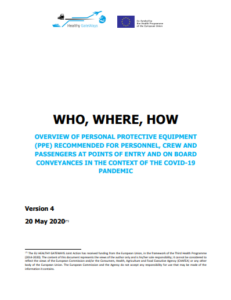ETF, ECSA and EMPA welcomed the new recommendations by the European Healthy GateWays on personal protective equipment (PPE) and call for a common approach for the health and safety of maritime transport workers.
To ensure European maritime professionals are able to do their jobs safely amid COVID-19 pandemic, it is important to have a clear and common approach on procedures applying to the physical interface between the vessels’ crew and external workers visiting the vessel, including pilots.
In their new statement, the industry representatives of European shipowners, European maritime pilots and European seafarers welcome the additional guidance provided by the EU Healthy GateWays on the recommended PPE and urge member states to effectively work towards the implementation of the guidance and adapt national guidance accordingly.
In practice, this would mean that all ‘visitors’ should wear PPE, (including masks) provided by their employers and apply rules of social distancing (maintaining a distance of at least 1,5m) when boarding a vessel. Serious consideration should also be given to the EHG’s recommendations regarding temperature testing.
EU Healthy GateWays guidance on the recommended PPE
- If it is considered necessary for shore-based personnel to board a ship, only the minimum number of personnel required should be allowed to board.
- Shore-based organizations should observe any protocols or screening measures (which could include temperature screening) that may be requested by visiting ships in the context of COVID-19
- PPE can be used with a two-fold purpose, to protect both shore-based personnel who temporarily board the ship as well as to protect the health of seafarers serving on board.
Requirements for protective measures when shore-based personnel board a ship, including which PPE should be used and when, can vary between countries with different national legal frameworks and can also vary between shipping companies . However, since ships sail between different ports and countries continuously, harmonization is needed regarding protocols to be implemented, including on which PPE should be used and when it must be used.
- To manage potential differences in procedures (including PPE required) between ship and shore-based organizations and develop a common approach, it will be important for ships to share their requirements for protective measures with shore-based organizations prior to arriving at the port.
- In the same manner, shore-based organizations should share their requirements with the ship to determine if they align. In the event that differences exist, ship and shore-based organizations should work to agree on measures that would be acceptable to both parties before the boarding of shore-based personnel on the ship.

EU States have adopted their own national guidance regarding the use of PPE and social distancing which has led to diverging guidance by the port and flag states.
This gives rise to health and safety concerns amongst those onboard in cases where shore based personnel boarding a ship, following national regulations, do not observe the protocols on wearing PPE and temperature testing provided by the visiting vessel.
The IMO’s guidance for ensuring good communications for a safe shipboard interface between ship and shore-based personnel will greatly assist in these cases.
Temperature Testing
EU Healthy GateWays have also suggested guidance on the possibilities for requiring temperature testing.
Pre-boarding screening efforts could be considered to assess incoming travellers for any symptoms or previous exposure to COVID-19 on vessels sailing on international or national voyages.
The following pre-boarding screening measures could be considered:
a) preboarding health questionnaire asking about symptoms and/or exposure and
b) temperature screening.
This could be implemented for large vessels with a long duration of voyage (several hours), including ferry boats and cruise-ferries for all crew and passengers. It could also be implemented for small sailing boats that are private or rented focusing on the incoming new crew members and less on passengers.
If a questionnaire will be used to assess the presence of symptoms and previous exposure to the disease, this can be given at the time of booking and then delivered to the designated crew member while boarding (web-based completion of the questionnaire would be a preferable option).
Explore more herebelow:
































































